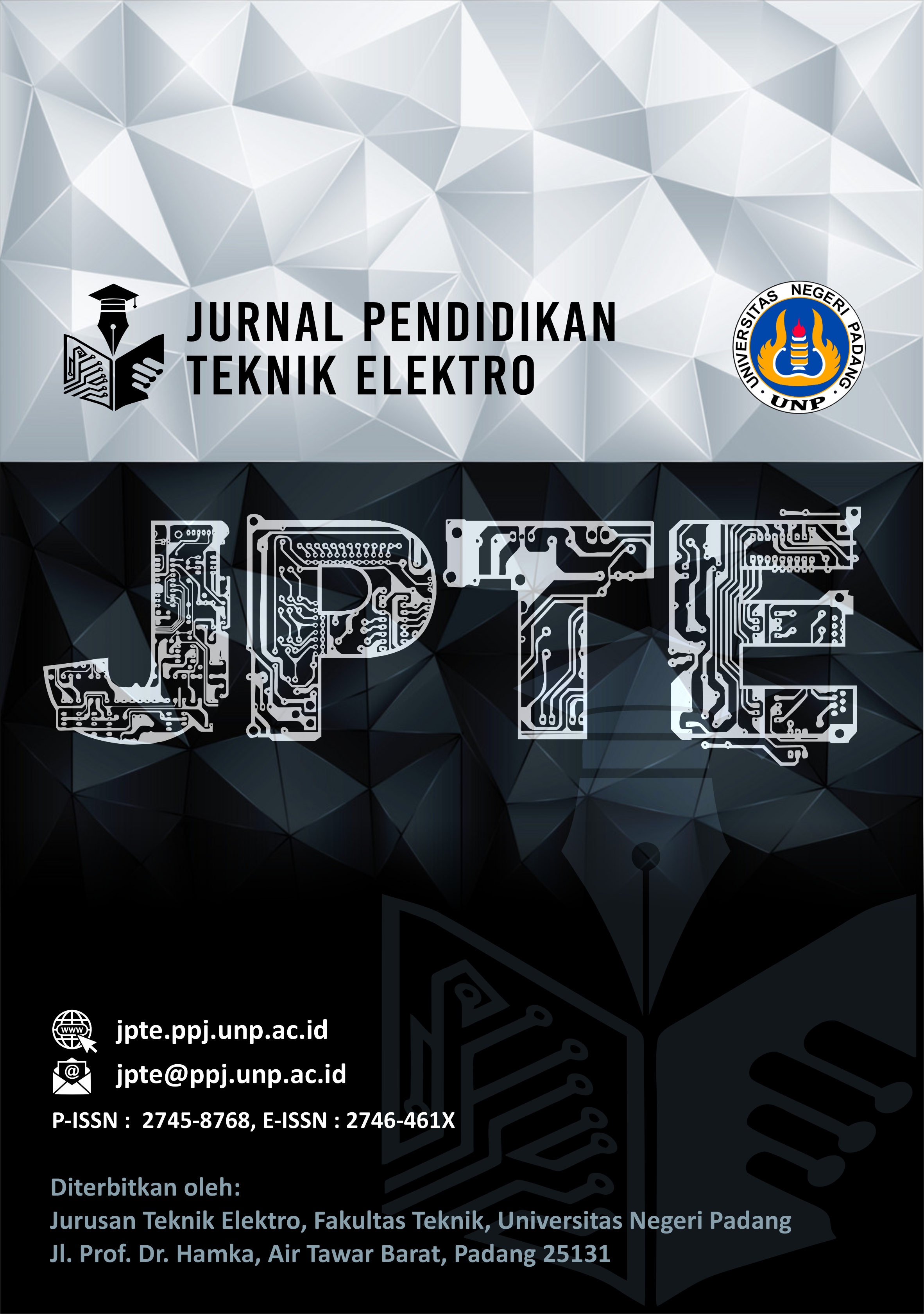Implementasi Metode Project-Based Learning berbantuan Video Pembelajaran pada Mata Pelajaran Instalasi Motor Listrik
##plugins.themes.academic_pro.article.main##
Abstract
Students in Vocational High Schools have low learning motivation when carrying out learning activities. This can happen because the way the material is delivered and the way the learning evaluation is carried out by the teacher tends to be monotonous and less creative so students feel bored, lazy, and less interested during the learning process. This causes student learning outcomes to be low. In the subject of Electric Motor Installation, there are many explanations of the material that are a little complicated for students to understand. Implementing the assistance of learning videos in the Project-Based Learning learning model, is considered quite effective in rekindling the enthusiasm for learning possessed by students. The objective to be achieved in this study is to find out the impact of implementing the Project-Based Learning model with the help of learning videos on the subject of Electric Motor Installation. The type of research used in this study is experimental research with a pre-experimental design type with a special design form, namely one group pretest-posttest. This research design is used to measure changes in students' understanding or learning outcomes before and after the application of the Project-Based Learning method assisted by learning videos. Based on the research that has been done, it was found that the application of the Project-Based Learning method assisted by learning videos has a positive impact on students' understanding and learning outcomes during the learning process in the Electric Motor Installation subject.
##plugins.themes.academic_pro.article.details##

This work is licensed under a Creative Commons Attribution 4.0 International License.
References
[2] Mulisyono, “Meningkatkan Hasil Belajar Peserta Didik kelas IV Dengan Menggunakan Media Google Meet,” SHEs: Conference Series, vol. 3, no. 3, p. 1920, 2020.
[3] D. Pristiwanti, B. Badriah, S. Hidayat, and S. Dewi, R., “Pengertian Pendidikan,” Jurnal Pendidikan dan Konseling, vol. 4, no. 6, pp. 7911–7913, 2022, doi: 10.33387/bioedu.v6i2.7305.
[4] A. A. P. Cattaneo, C. Antonietti, and M. Rauseo, “How digitalised are vocational teachers? Assessing digital competence in vocational education and looking at its underlying factors,” Comput Educ, vol. 176, p. 104358, Jan. 2022, doi: https://doi.org/10.1016/J.COMPEDU.2021.104358.
[5] T. N. Azis, “Strategi pembelajaran era digital,” Annual Conference on Islamic Education and Social Sains (ACIEDSS), vol. 1, no. 2, pp. 308–309, 2019.
[6] R. Farista and I. Ali, M, “Pengembangan Video Pembelajaran,” Universitas Muhammadiyah Sidoarjo, vol. 53, no. 9, p. 1, 2018.
[7] M. Nugraha, “Manajemen Kelas Dalam Meningkatkan Proses Pembelajaran,” Tarbawi: Jurnal Keilmuan Manajemen Pendidikan, vol. 4, no. 01, p. 28, 2018, doi: 10.32678/tarbawi.v4i01.1769.
[8] M. Korber and D. Oesch, “Vocational versus general education: Employment and earnings over the life course in Switzerland,” Adv Life Course Res, vol. 40, pp. 1–13, 2019, doi: https://doi.org/10.1016/j.alcr.2019.03.003.
[9] C. Amelia, “Problematika pendidikan di Indonesia,” Prosiding Seminar Nasional Fakultas Ilmu Sosial Universitas Negeri Medan, vol. 3, p. 776, 2019.
[10] J. Vorhaus, “Learning Styles in Vocational Education and Training,” International Encyclopedia of Education, pp. 376–382, Jan. 2010, doi: 10.1016/B978-0-08-044894-7.00785-5.
[11] H. Susanto, “Faktor-faktor yang mempengaruhi kinerja guru sekolah menengah kejuruan,” Jurnal Pendidikan Vokasi, vol. 2, no. 2, p. 198, 2013, doi: 10.21831/jpv.v2i2.1028.
[12] M. F. Azzikri and M. Yuhendri, “Penerapan Problem-Based Learning pada Mata Pelajaran Instalasi Penerangan Listrik,” Jurnal Pendidikan Teknik Elektro (JPTE), vol. 05, no. 01, p. 119, 2024.
[13] H. Irpando, Purwantono, S. Budi, and Adri Junil, “Peningkatan Hasil Belajar Mata Pelajaran Teknik Gambar Manufaktur Menggunakan Metode Problem Based Learning Berbasis Media Visual Pada Siswa Kelas Xi Teknik Pemesinan Di Smk Negeri 1 Sumatera Barat,” Journal of Social and Economics Research, vol. 5, no. 2, p. 65, 2023, doi: 10.54783/jser.v5i2.111.
[14] L. S. Wahyuni and Sukardi, “Efektivitas Penerapan Model Problem-Based Learning pada Mata Pelajaran Instalasi Motor Listrik,” Jurnal Pendidikan Teknik Elektro (JPTE), vol. 4, no. 2, p. 251, 2023.
[15] M. Affandi, E. Chamalah, and O. P. Wardani, Model Dan Metode. 2013.
[16] L. Syarifah, I. Holisin, and S. Shoffa, “Meta Analisis: Model Pembelajaran Project Based Learning,” Jurnal Penelitian Pembelajaran Matematika, vol. 14, no. 2, p. 258, 2021.
[17] T. Mayasari, A. Kadarohman, D. Rusdiana, and I. Kaniawati, “Apakah Model Pembelajaran Problem Based Learning Dan Project Based Learning Mampu Melatihkan Keterampilan Abad 21?,” Jurnal Pendidikan Fisika dan Keilmuan (JPFK), vol. 2, no. 1, p. 53, 2016, doi: 10.25273/jpfk.v2i1.24.

